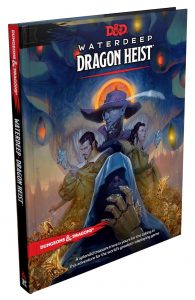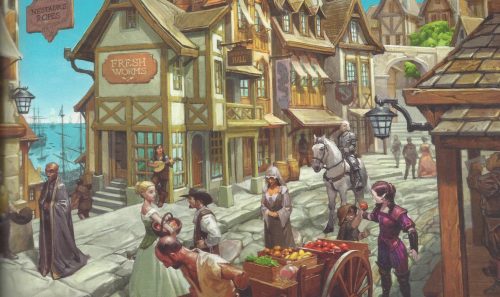Welcome to Purple Pawn, covering games played around the world by billions of people every day.
 Wizards of the Coast’s Waterdeep Dragon Heist adventure for Dungeons & Dragons is something very different and I’m of two minds about it. Meant for characters levels 1-5, it’s no dungeon crawl, MacGuffin quest, or wilderness expedition, rather an investigative style adventure set in one of the Forgotten Realms’ most famous urban locales. Supplementing that part of the book is a 25 page visitor’s guide to Waterdeep written from the perspective of an iconic Realms character.
Wizards of the Coast’s Waterdeep Dragon Heist adventure for Dungeons & Dragons is something very different and I’m of two minds about it. Meant for characters levels 1-5, it’s no dungeon crawl, MacGuffin quest, or wilderness expedition, rather an investigative style adventure set in one of the Forgotten Realms’ most famous urban locales. Supplementing that part of the book is a 25 page visitor’s guide to Waterdeep written from the perspective of an iconic Realms character.
On the positive side, Dragon Heist provides a distinctive fun adventure for low-level characters, one that combines interesting combat encounters with a variety of roleplaying opportunities, engaging story, and intrigue-filled backdrop. Part of the way through, the players’ characters may end up owning their own city property to use as a base of operations.
I love how Dragon Heist brings the city of Waterdeep to life with social and political factions, historic and mundane locations, and oh so many characters! The complex life of the city is even reflected in the art, which features a number of normal looking street scenes.
On the negative side are difficult to accept plot devices and confusing superfluous content. Now perhaps I should be more willing to suspend disbelief—players in the games I run tend to be a lot more forgiving—but some of these are very weak or poorly constructed. There’s the sentient artifact that resists revealing its secret to anyone but the player characters, the search for a creature that comes down to borrowing someone’s already-made custom detector device, bad guys that bungle their schemes just enough to attract the characters’ attention, and chase scenes rigged for a certain result.
What bothers me the most, though, is not the adventure but the structure of the product. The book takes 60 pages to describe lairs that, if the story unfolds as intended, the players should never visit. And, while the ultimate prize offered the characters is the same, the book presents four alternate antagonists, each with their own extended encounter sequence. The situations faced in these alternate encounters are different but they’re set in many of the same locations. Except, in a way, the secret location of the ultimate prize. That depends, for no apparent reason, on whom the DM has chosen to oppose the characters.
Why this convoluted setup? More than unnecessary, it creates major characters with inspiring motivations for the story line but then asks you to ignore most of them. I suggest two possible explanations. One, it fills out the page count. The essential part of the adventure is just not enough for a $50 hardcover. Or two, it’s designed to support streaming. Four alternatives to a significant part of the story means more variety among the groups streaming their games, as well as improving the possibility of groups playing at home without the whole story being spoilered by a favorite stream.
With all of this in mind, Waterdeep Dragon Heist presents a fine adventure that is particularly well-suited for new players or others who might be looking for more mystery and more role-playing than dungeon-raiding. New Dungeon Masters, however, might find the details, complexities, and difficult plot issues a bit much to handle. Otherwise, it is a fantastic resource for an urban campaign in the Forgotten Realms. There is so much more than the one story in this product to inspire a DM, hints, hooks, locations, legends, and complex characters.

A complimentary copy of Waterdeep Dragon Heist was provided by Wizards of the Coast for review.
1 Comment
Sorry, the comment form is closed at this time.
Trending
- Massdrop.com
- Oh the Irony—Illuminati Card Game Continues to Inspire Conspiracy Theorists
- Footprints, an Educational Ecology Game
- Home
- USPS Adds Board Game Flat Rate Box
- Baila, the Estonian Drinking Card Game
- Crystal Caste Wins Dice Patent Suit Against Hasbro
- Mirror Game, Red and Blue
- Are Board Games Dangerous?
- Board Games Based on Hindu Mythology
Archives
Most Popular Articles
- Oh the Irony—Illuminati Card Game Continues to Inspire Conspiracy Theorists
- The 20 Most Valuable Vintage Board Games
- The Truth About Dominoes On Sunday in Alabama
- Sequence Game, and Variants
- USPS Adds Board Game Flat Rate Box
- Baila, the Estonian Drinking Card Game
- The 13 Most Popular Dice Games
- Are Board Games Dangerous?
- Guess Who? The Naked Version
- What Happened to the Jewel Royale Chess Set?
Recent Posts
- Toy Fair 2019—Breaking Games
- Talisman Kingdom Hearts Edition
- Toy Fair 2019—Winning Moves
- Toy Fair 2019—Games Workshop
- Toy Fair 2019—Star Wars Lightsaber Academy
- Toy Fair 2019—Stranger Things Games
- Toy Fair 2019—HABA
- Licensing Roundup
- Game Bandit
- 2018 A Difficult Year For Hasbro But Not For D&D Or MtG
Recent Comments
- on Toy Fair 2019—Winning Moves
- on Game Bandit
- on Second Look—Dungeons & Dragons Waterdeep Dragon Heist
- on Crowdfunding Highlights
- on Beyblade SlingShock
- on Game Bandit
- on Game Bandit
- on Watch This Game!, the Board Game Review Board Game
- on Second Look—Vampire: The Masquerade 5th Edition
- on Palladium Books Loses Robotech IP License, Cancels Five-Year-Overdue Robotech RPG Tactics Kickstarter





I agree with a lot of what is written above. Of the lairs, I can only think of two of the four that the heroes might actually find themselves at, as the course of the adventure takes place. And of those, neither seem to be scenes where there’s the exploration or dungeon crawl aspects of these areas.
Regarding the fun bulk of the adventure — the merry chase through Waterdeep for the MacGuffin — the word “convoluted” is most appropriate. It is a forty-page section made up of ten encounter areas that are presented in a way that ensures one has to read and re-read the section, flipping back and forth through pages, to determine what the heck is going on. As the villain is determined by the season, there are four direct, linked paths of scenes to follow: the presentation of this sequence is unhelpful to anyone using this book. For instance, in summer, you’re running encounters 4, 10, 5, 1, 3, 9, 8, and 7, in that order. In the write up for encounter 7, there are complete blocks of what happens if it’s summer, autumn, or winter. I suspect this section is so purposely disorganized that if WotC did just print this as a chapter that listed the sequence of events per season, one after another, buyers might be upset when they realize that thirty pages out of a forty-page section is unusable in their game.
That this is followed up by the Dungeon of the Mad Mage reminds me of the issues I had with Princes of the Apocalypse. While there is an interesting area outside the dungeon, full of interesting people and politics, intrigue, and adventure, once you get into the underground dungeon, play just shifted to a room-by-room wargame with no actual need to return to the things and people you’re trying to protect. I’ve only just started to glance through Mad Mage but it doesn’t seem like there’s much to it apart from a series of rooms to kill and plunder through.